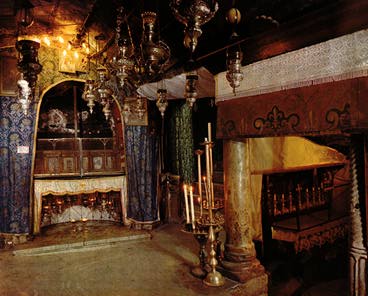Bethlehem of Judah (to be distinguished from Bethlehem of Galilee) is located approximately 6 miles southwest of Jerusalem, in the southern portion of the Judean Mountains. The name, “Bethlehem,” or in Hebrew, “Bet Lehem,” translates literally to mean, “House of Bread.” It is situated at approximately 2,543 feet above mean sea level.
The climate of Bethlehem is typically Mediterranean, with dry summers with temperatures into the low- to mid-eighties, and cold damp winters, with temperatures getting as low as the mid-thirties. Average annual rainfall is 28 inches.
In 338 C.E., Helena (mother of the Emperor Constantine) had a church built over the grotto that is traditionally held to be the birthplace of Jesus. Christian tradition affirming the site to be the birthplace of Christ goes back to at least the Second Century, when Justin Martyr identified “a cave outside of the town” as the birthplace of Jesus; in the Third Century, Origen of Alexandria claimed that the townspeople had pointed out the specific location of the Nativity.
The town itself was bitterly contested during the period of the Crusades, from its initial capture by Crusaders in 1100, until the final defeat of the Crusaders and their expulsion from Palestine in 1291.
And Rachel died, and was buried in Eph’rath, which is Bethlehem. And Jacob set a pillar upon her grave: that is the pillar of Rachel’s grave unto this day.
Genesis 35:19, 20
As the traditional place of Rachel’s burial (in addition to being the birthplace of Jesus), Bethlehem is also sacred to Jews and Moslems, who make regular pilgrimages to the site of Rachel’s tomb.
In modern times, the traditional claims for Bethlehem of Judah being the place of Christ’s birth has become the subject of scholarly dispute, with some scholars claiming that there is no historical or archaeological case to support the claims. These scholars claim that Scripture is not to be taken literally, but rather that the use of Bethlehem of Judah was used as a sort of literary device in the narrative of Christ’s birth. Others make the claim that the Gospel writers used the location in order to bolster claims of fulfilled prophecy, and yet another school of reasoning holds that Jesus was not born in Bethlehem at all, but rather in Nazareth.
However, most of these scholars disavow any scriptural references that contain supernatural implications, such as fulfilled prophecy; it is also worth noting that other claims made by certain groups of historians could not hold up unless the traditional location of Jesus’s birth is disqualified. For instance, there are claims by many of the biographers of Herod, who state that the “Slaughter of the Innocents”—the massacre of all infant males in Bethlehem at the time of Christ’s birth—never actually happened, which would validate the claim that the Gospel authors resorted to some creative license in their record of the Nativity. Given the insignificance of the town in Herod’s day, the fact that there was no method for news to travel quickly, and the general ruthlessness that characterized the reign of Herod (who murdered three of his own sons in a bid to retain power), these claims are at best speculative, and at worst specious.



